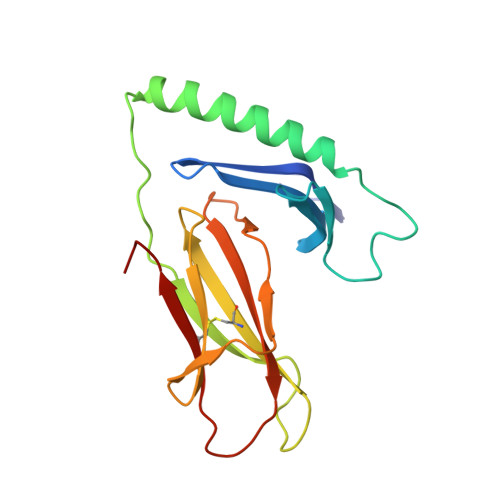N-terminal additions to the WE14 peptide of chromogranin A create strong autoantigen agonists in type 1 diabetes.
Jin, N., Wang, Y., Crawford, F., White, J., Marrack, P., Dai, S., Kappler, J.W.(2015) Proc Natl Acad Sci U S A 112: 13318-13323
- PubMed: 26453556
- DOI: https://doi.org/10.1073/pnas.1517862112
- Primary Citation of Related Structures:
5DMK - PubMed Abstract:
Chromogranin A (ChgA) is an autoantigen for CD4(+) T cells in the nonobese diabetic (NOD) mouse model of type 1 diabetes (T1D). The natural ChgA-processed peptide, WE14, is a weak agonist for the prototypical T cell, BDC-2.5, and other ChgA-specific T-cell clones. Mimotope peptides with much higher activity share a C-terminal motif, WXRM(D/E), that is predicted to lie in the p5 to p9 position in the mouse MHC class II, IA(g7) binding groove. This motif is also present in WE14 (WSRMD), but at its N terminus. Therefore, to place the WE14 motif into the same position as seen in the mimotopes, we added the amino acids RLGL to its N terminus. Like the other mimotopes, RLGL-WE14, is much more potent than WE14 in T-cell stimulation and activates a diverse population of CD4(+) T cells, which also respond to WE14 as well as islets from WT, but not ChgA(-/-) mice. The crystal structure of the IA(g7)-RLGL-WE14 complex confirmed the predicted placement of the peptide within the IA(g7) groove. Fluorescent IA(g7)-RLGL-WE14 tetramers bind to ChgA-specific T-cell clones and easily detect ChgA-specific T cells in the pancreas and pancreatic lymph nodes of NOD mice. The prediction that many different N-terminal amino acid extensions to the WXRM(D/E) motif are sufficient to greatly improve T-cell stimulation leads us to propose that such a posttranslational modification may occur uniquely in the pancreas or pancreatic lymph nodes, perhaps via the mechanism of transpeptidation. This modification could account for the escape of these T cells from thymic negative selection.
Organizational Affiliation:
Howard Hughes Medical Institute, Denver, CO 80206; Department of Biomedical Research, National Jewish Health, Denver, CO 80206; Barbara Davis Center for Childhood Diabetes, University of Colorado, Aurora, CO 80045;
















